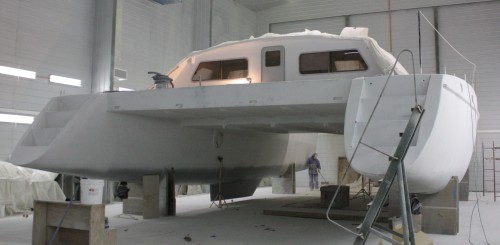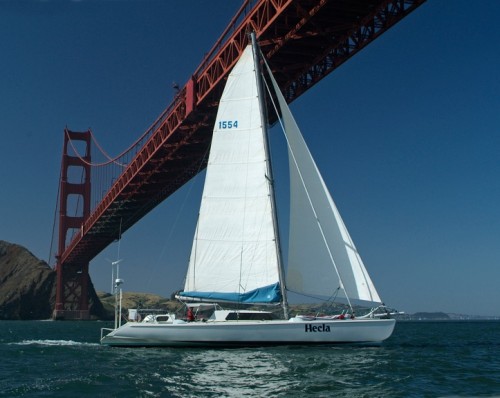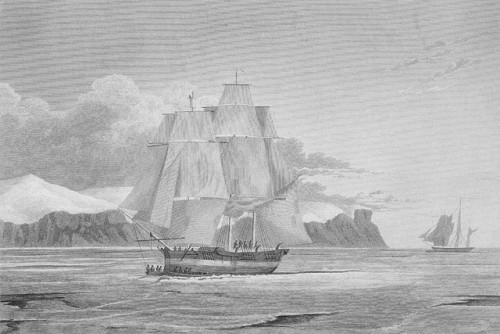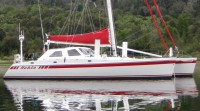
Exploring the World by Sail from A to Z
Jeff and Zia's adventures aboard the catamaran Hekla
12 January 2015 | 62 31'S:59 47'W, Antarctic Peninsual
09 January 2015 | 65 54'S:62 52'W, Antarctic Peninsual
07 January 2015 | 65 15'S:64 16'W, Antarctic Peninsual
04 January 2015 | 64 19'S:62 55'W, Antarctic peninsula
31 December 2014 | 54 48'S:68 19'W, Ushuaia
27 December 2014 | It's 6am must be Miami...
26 December 2014 | Guatemala
09 June 2013 | 17 35'N:80 42'W, Caribbean sea
06 June 2013 | Jamaica
04 June 2013 | 18 28'N:77 57'W, Montego Bay
02 June 2013 | 19 20'N:78 49'W, on passage Cayman-Jamaica
23 May 2013 | 19 43'N:82 58'W, south of Cuba, NW of Cayman
19 May 2013 | 24 34'N:81 49'W, Key West, Florida
30 April 2013 | 23 25'N:85 38'W, Gulf of Mexico
27 April 2013 | 21 15'N:86 45'W, Isla Mujeras
19 April 2013 | 18 17'N:87 50'W, Xcalak
17 April 2013 | 15 34'N:89 12'W, Lago Izabal, Guatemala
10 April 2013 | Rio Dulce
10 April 2013 | 15 39'N:88 'W, Rio Dulce
01 April 2013 | 16 05'N:88 32'W, Southern Belize
The catamaran Hekla
20 August 2011
Jeff

Hekla is an Atlantic 57 catamaran, the premier performance cruising catamaran by multihull designer Chris White.
"Why a catamaran? I thought you were a tri guy."
True, I do like the lines of the trimaran better than a cat, and tri's are generally faster in cruising trim, primarily because the accommodations are more restricted and usually the tri is much lighter than a cat of the same length. I picked the cat this time because of the generous living accommodations, crew capability, and built in redundancies such as dual engines and rudders. While we often plan to cruise double-handed, we will enjoy sharing the experience with a full house of guests from time to time.
"Is this a custom boat?"
Yes and no. It is not a production boat, but neither is it a custom hull and sailplan design just for me. Chris White is a long-time multihull sailor and designer, and his business is to design a range of boat models and then assist the client with the construction of the boat by a custom builder. I picked the model from Chris's lineup, and then picked nearly all of the fitout to my wishes, such as engines, electronics, wood trim, paint scheme, etc. Chris is currently recommending that his boats be built by Alwoplast S.A., in Valdivia, Chile. My boat is the 8th Atlantic 57 produced in that shop over 4 years. Chris also designed the trimaran Hecla, a Hammerhead 54.
"My that is a big boat!"
Again, yes and no. Length is a big advantage for an ocean going boat; adding length adds stability, safety, speed. But it can also add temptation to fill it up with accommodations. Other catamarans of this length may have sleeping for 10 or 12, 4 or more heads (toilets), elevated steering platforms, big engines, a diesel generator, ... on and on just more stuff. Chris's designs are long and lean, my favorite feature of his design philosophy. Bring on the length for safety, comfort, and speed, but keep it light and lean. Hekla is pressed to sleep 8, has only 2 toilets, no A/C or genset, modest engines. The installations are simple, the sail-plan is not complicated. That said, however, these are big sails with lots of power, and proper technique must be used to handle them safely.
"What about the electronics? Were you involved in the selection?"
Oh yes, that is very important to me; I spent over a year working it out. In the past I have used Garmin GPS exclusively, however 18 months ago I was planning to avoid that company, largely because of how they have de-evolved their computer software that supports the field devices, to the point of general uselessness. MapSource was such a great program, but instead of adding a little module to allow communication with the newest devices and their different memory structure, they have obsoleted that product and replaced it with BaseCamp and HomePort, both quite inferior to MapSource, and still not fully supported on the Mac platform. Gone are the days of easy map, waypoint, route and track transfer between PC and device via USB; now nearly everything has to be done with memory chips. I think they chose to disappoint a few power users in favor of vastly simplifying the customer support overhead needed for their ever-lower common denominator of customer base. However their hardware is still tremendous, and the reason I selected an all-Garmin platform is the industry-best selection of sailboat electronics that they offer. The weather and depth instruments, chartplotters, primary GPS navigator, VHF radio, AIS, and now even the autopilot is Garmin, and it all talks to each other over the NMEA2000 network. Having all the parts from one manufacturer generally means that they will work together, and even though the NMEA network standard says that all brands talk the same language, I have experienced otherwise.
I want to sing praises of at least one piece of Garmin equipment, the GPSMAP740s. It is a smallish touchscreen chartplotter that is designed to meet all basic boat navigation needs with a very low power consumption. It is specified and I have measured 8.4 watts with its own depth sounder attached; this is a fraction of any other panel mount GPS on the market. It is my always-on primary GPS and located at the navigation station. There are two other chartplotters, one at the forward cockpit steering station and the other at the pilot house steering station. Those, with their larger screens and networked radar display, will be used for coastal navigation but generally powered off during ocean passages because they draw quite a bit of power. The other that I think is a great design but remains to be tested is the newly released autopilot. I believe it is the only sailboat specific autopilot that is also fully NMEA2000 compliant, and knowing Garmin's hardware engineering it is likely to be a winner. I have two for redundancy, one per rudder, though only one can be used at a time.
AIS, or Automatic Identification System, is a must have collision avoidance tool for me who has primarily solo sailed in the last several years. All of the larger ships are required (and most actually do) transmit position and course information on a VHF frequency, and an AIS receiver will decode those transmissions and computes a distance to the ship, sounding an alarm if necessary. This system is so important that I carry two, Garmin VHF-AIS300 and AIS600. The latter is also a position transmitter, which will only be used in the open ocean, and not when we are in crowded harbors or might prefer to run dark.
The instruments are divided up into two groups, "anchoring" and "sailing." The anchoring instruments are selected for low energy consumption: the primary GPS 740s, weather, depth, and alarms, particularly the anchor drag alarm. The remainder are used only while underway.
"You keep mentioning energy consumption, explain why that is so important."
This boat is intended to live off of the dock, out sailing and anchoring, so almost always must generate all of its own electric energy. There are solar panels and a wind generator, but even in ideal conditions those will provide roughly half of the daily electric energy needs, the remainder from engine charging. I really don't like running the engine when I don't need to, and a thorough review of energy consumption can reduce engine time quite a bit.
However the big tool for reducing engine time for battery charging is the battery and charging system itself. I have selected lithium iron phosphate batteries (320 A-hr/28v from RaceCell) and dual high-capacity alternators (API 180A/28v from Bruce Schwaab Systems) on the charging engine to be able to charge at a maximum rate of 300A at 28 volts, that's about 10 times greater than the Volvo stock alternator system. A full battery charge cycle can be completed in just under an hour. This is only possible with the lithium battery chemistry with its high charge acceptance rate, compared to lead acid batteries which by their chemistry require over two hours for a full charge cycle no matter how much power is available from the engine. I have become very sensitive to long battery charging from charter boat experience, those boats usually have stock alternator systems and need 4 hours daily run time, quite a bummer when even in beautiful sailing conditions we need that much engine time just to keep the fridge cool and autopilot working. The lithium battery system was unfamiliar to Alwoplast, so it is my design and my responsibility to commission.
By the way both engine starting batteries are special purpose starting batteries from RaceCell, they are about the size and weight of a small grapefruit but reportedly crank a diesel engine like a big 4-D lead pack. Also to be tested...
"So with all this electric energy talk you didn't do that electric cooking thing again, did you?"
Sure did and I love it. There is a great technical article on the Victron Energy web site about electric cooking on a sailboat, it's a good read and it agrees with my calculations that, with proper appliance selection, cooking will only consume about 20% of the daily electric energy needs. Those devices that are on all the time, such as autopilot, refrigeration, and stereo, are the big consumers. With electric cooking I have far less fire hazard, no carbon monoxide hazard, and no hassle trying to fill a propane tank in a foreign port where there are no familiar tank fitting standards. I have two induction cooktops, a rice cooker, George Foreman grill as the workhorses and an espresso machine for luxury. I do admit, baking cookies is a challenge and electric cooking does rely upon complex mechanical and electrical systems to deliver the energy.
"Why a catamaran? I thought you were a tri guy."
True, I do like the lines of the trimaran better than a cat, and tri's are generally faster in cruising trim, primarily because the accommodations are more restricted and usually the tri is much lighter than a cat of the same length. I picked the cat this time because of the generous living accommodations, crew capability, and built in redundancies such as dual engines and rudders. While we often plan to cruise double-handed, we will enjoy sharing the experience with a full house of guests from time to time.
"Is this a custom boat?"
Yes and no. It is not a production boat, but neither is it a custom hull and sailplan design just for me. Chris White is a long-time multihull sailor and designer, and his business is to design a range of boat models and then assist the client with the construction of the boat by a custom builder. I picked the model from Chris's lineup, and then picked nearly all of the fitout to my wishes, such as engines, electronics, wood trim, paint scheme, etc. Chris is currently recommending that his boats be built by Alwoplast S.A., in Valdivia, Chile. My boat is the 8th Atlantic 57 produced in that shop over 4 years. Chris also designed the trimaran Hecla, a Hammerhead 54.
"My that is a big boat!"
Again, yes and no. Length is a big advantage for an ocean going boat; adding length adds stability, safety, speed. But it can also add temptation to fill it up with accommodations. Other catamarans of this length may have sleeping for 10 or 12, 4 or more heads (toilets), elevated steering platforms, big engines, a diesel generator, ... on and on just more stuff. Chris's designs are long and lean, my favorite feature of his design philosophy. Bring on the length for safety, comfort, and speed, but keep it light and lean. Hekla is pressed to sleep 8, has only 2 toilets, no A/C or genset, modest engines. The installations are simple, the sail-plan is not complicated. That said, however, these are big sails with lots of power, and proper technique must be used to handle them safely.
"What about the electronics? Were you involved in the selection?"
Oh yes, that is very important to me; I spent over a year working it out. In the past I have used Garmin GPS exclusively, however 18 months ago I was planning to avoid that company, largely because of how they have de-evolved their computer software that supports the field devices, to the point of general uselessness. MapSource was such a great program, but instead of adding a little module to allow communication with the newest devices and their different memory structure, they have obsoleted that product and replaced it with BaseCamp and HomePort, both quite inferior to MapSource, and still not fully supported on the Mac platform. Gone are the days of easy map, waypoint, route and track transfer between PC and device via USB; now nearly everything has to be done with memory chips. I think they chose to disappoint a few power users in favor of vastly simplifying the customer support overhead needed for their ever-lower common denominator of customer base. However their hardware is still tremendous, and the reason I selected an all-Garmin platform is the industry-best selection of sailboat electronics that they offer. The weather and depth instruments, chartplotters, primary GPS navigator, VHF radio, AIS, and now even the autopilot is Garmin, and it all talks to each other over the NMEA2000 network. Having all the parts from one manufacturer generally means that they will work together, and even though the NMEA network standard says that all brands talk the same language, I have experienced otherwise.
I want to sing praises of at least one piece of Garmin equipment, the GPSMAP740s. It is a smallish touchscreen chartplotter that is designed to meet all basic boat navigation needs with a very low power consumption. It is specified and I have measured 8.4 watts with its own depth sounder attached; this is a fraction of any other panel mount GPS on the market. It is my always-on primary GPS and located at the navigation station. There are two other chartplotters, one at the forward cockpit steering station and the other at the pilot house steering station. Those, with their larger screens and networked radar display, will be used for coastal navigation but generally powered off during ocean passages because they draw quite a bit of power. The other that I think is a great design but remains to be tested is the newly released autopilot. I believe it is the only sailboat specific autopilot that is also fully NMEA2000 compliant, and knowing Garmin's hardware engineering it is likely to be a winner. I have two for redundancy, one per rudder, though only one can be used at a time.
AIS, or Automatic Identification System, is a must have collision avoidance tool for me who has primarily solo sailed in the last several years. All of the larger ships are required (and most actually do) transmit position and course information on a VHF frequency, and an AIS receiver will decode those transmissions and computes a distance to the ship, sounding an alarm if necessary. This system is so important that I carry two, Garmin VHF-AIS300 and AIS600. The latter is also a position transmitter, which will only be used in the open ocean, and not when we are in crowded harbors or might prefer to run dark.
The instruments are divided up into two groups, "anchoring" and "sailing." The anchoring instruments are selected for low energy consumption: the primary GPS 740s, weather, depth, and alarms, particularly the anchor drag alarm. The remainder are used only while underway.
"You keep mentioning energy consumption, explain why that is so important."
This boat is intended to live off of the dock, out sailing and anchoring, so almost always must generate all of its own electric energy. There are solar panels and a wind generator, but even in ideal conditions those will provide roughly half of the daily electric energy needs, the remainder from engine charging. I really don't like running the engine when I don't need to, and a thorough review of energy consumption can reduce engine time quite a bit.
However the big tool for reducing engine time for battery charging is the battery and charging system itself. I have selected lithium iron phosphate batteries (320 A-hr/28v from RaceCell) and dual high-capacity alternators (API 180A/28v from Bruce Schwaab Systems) on the charging engine to be able to charge at a maximum rate of 300A at 28 volts, that's about 10 times greater than the Volvo stock alternator system. A full battery charge cycle can be completed in just under an hour. This is only possible with the lithium battery chemistry with its high charge acceptance rate, compared to lead acid batteries which by their chemistry require over two hours for a full charge cycle no matter how much power is available from the engine. I have become very sensitive to long battery charging from charter boat experience, those boats usually have stock alternator systems and need 4 hours daily run time, quite a bummer when even in beautiful sailing conditions we need that much engine time just to keep the fridge cool and autopilot working. The lithium battery system was unfamiliar to Alwoplast, so it is my design and my responsibility to commission.
By the way both engine starting batteries are special purpose starting batteries from RaceCell, they are about the size and weight of a small grapefruit but reportedly crank a diesel engine like a big 4-D lead pack. Also to be tested...
"So with all this electric energy talk you didn't do that electric cooking thing again, did you?"
Sure did and I love it. There is a great technical article on the Victron Energy web site about electric cooking on a sailboat, it's a good read and it agrees with my calculations that, with proper appliance selection, cooking will only consume about 20% of the daily electric energy needs. Those devices that are on all the time, such as autopilot, refrigeration, and stereo, are the big consumers. With electric cooking I have far less fire hazard, no carbon monoxide hazard, and no hassle trying to fill a propane tank in a foreign port where there are no familiar tank fitting standards. I have two induction cooktops, a rice cooker, George Foreman grill as the workhorses and an espresso machine for luxury. I do admit, baking cookies is a challenge and electric cooking does rely upon complex mechanical and electrical systems to deliver the energy.
Our Mission
03 August 2011
Jeff

I bought the trimaran Hecla in 2007. My goal then was to become competent in ocean sailing and begin long-range blue-water sailing in 2011, the year I became an empty nester. I chose as my training platform to compete in the Singlehanded Transpacific Yacht Race organized by the Singlehanded Sailing Society of San Francisco Bay, an organization of very friendly and somewhat eccentric folks, whose own mission is to promote safety and seamanship through training and sharing of ideas in a cooperative and competitive arena. Why couldn't I just sail to Hawaii on my own? Sure, lists of recommended offshore safety equipment abound, just run down one of those and take off.... I know myself well enough to know that I might get 80% through that list and call it good enough. But for an organized, inspected race, there are no exceptions, no bending the rules. Get it right or stay home. I needed that discipline. My former boss and colleague used to say: "Wise people learn from the mistakes of others." The SSS offered seminars, pubby war stories, and camaraderie for learning before the race started, and endless personal challenges during the +/- two weeks of the TransPac solo sailing on the wide ocean blue.
OK, I did it. Twice even, 2008 and 2010. Some sailors get drawn to that event like bugs to a light...
Hecla has claimed new ownership as of July 2011, and is expected to be plying the Caribbean and other Atlantic waters soon.
Hold on, I'm getting off track. I am supposed to be writing about The Mission.
The trimaran Hecla's mission was: "To cross oceans and explore the coastal lands where yachts seldom visit." Off the beaten path so to speak, almost like Parry and crew, though uncharted waters don't really exist any more. Hecla's mission was only partially completed while under my ownership, however the mission passes in its entirety to the new catamaran Hekla.
OK, I did it. Twice even, 2008 and 2010. Some sailors get drawn to that event like bugs to a light...
Hecla has claimed new ownership as of July 2011, and is expected to be plying the Caribbean and other Atlantic waters soon.
Hold on, I'm getting off track. I am supposed to be writing about The Mission.
The trimaran Hecla's mission was: "To cross oceans and explore the coastal lands where yachts seldom visit." Off the beaten path so to speak, almost like Parry and crew, though uncharted waters don't really exist any more. Hecla's mission was only partially completed while under my ownership, however the mission passes in its entirety to the new catamaran Hekla.
Our Namesake
03 August 2011

Above is an llustration of HMS Hecla and Fury sailing through young ice during William Edward Parry's third exploration for a Northwest Passage, 1824-1825. By naming my former trimaran Hecla and the new catamaran Hekla we honor Parry's expert command, and the unprecedented scientific exploration and Inuit contacts achieved.
| Vessel Name: | Hekla |
| Vessel Make/Model: | Atlantic 57, Chris White Designs |
| Hailing Port: | Fort Collins, Colorado, USA |
| Crew: | Jeff Lebesch, Zia Zybko |
| About: | Jeff has been sailing for 11 years, and has completed two singlehanded TransPac races on his former trimaran Hecla. Zia is enthusiastic about adventure-exploration by sail |
Gallery not available
S/V Hekla

Who: Jeff Lebesch, Zia Zybko
Port: Fort Collins, Colorado, USA
Contents
hiccup